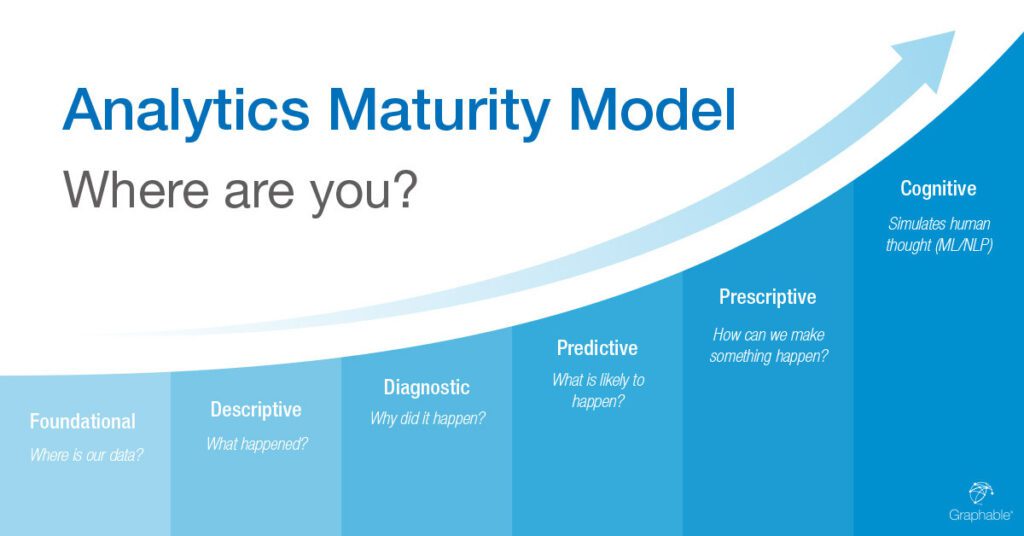CONTACT US
The 6 Stages of the Analytics Maturity Model
The analytics maturity model maps the data analytics journey and stages that companies experience as they progress in their understanding and use of their data. The maturity model gives context to where you are in the process and the stages ahead. In this article, we explain the important aspects and value of each step of the analytics maturity model and how and why to invest in this increasingly important aspect of any business or organization.
Need analytics help? Check out our data analytics consulting services and how we can help you make better and faster decisions with the right data at your fingertips.
What is the Analytics Maturity Model?
Companies make significant decisions all the time based on their data. To make better business decisions, companies do not generally need better data – they need better hygiene, discipline and insights from that data. The analytics maturity model outlines the most common stages that organizations move through as they mature, and as they are seeking deeper and more helpful insights from their data.
This is almost never a perfectly linear journey. Companies generally are not even cognizant of where they are in it, but when they see these stages, they often recognize elements of various stages and oftentimes unique strengths and weaknesses in one stage vs another. The main point of the model is to help identify your approximate position and strengths, as well as the gaps and areas for improvement.
Of the 6 stages of the analytics maturity model, the beginning two stages are part of a starting point foundation. Once those are strong and reliably in place, companies should continue to push beyond, striving for more value and insights from their data, insights to be found in the other stages.

What Are the 6 Stages of the Model?
Foundational
The first stage of the analytics maturity model is Foundational. This stage is the entry point into the data analytics journey. Companies that are only in this stage are transitioning to prioritize and understand what data they have and where it resides. Organizations start to ask questions such as “What information do I need to make better business decisions?“, and “How can I obtain that information?“. These are the foundation of not just this stage but the whole analytics maturity model. Companies should focus on implementing a data management and data governance framework to store, manage and ensure the integrity of their data while also focusing on cultural readiness within the organization.
Descriptive
The second stage of the analytics maturity model is Descriptive. Data and reports in this stage answer the question “What happened?”. Some example questions could be, “How many quotes did we create?“, “How many of those quotes converted to sales?“, “How much revenue came from those sales?” as a few. All these questions are backward-looking, focusing on what the historical data shows already happened. Companies rely on this information, combined with benchmark data to make business decisions about how they might need to course correct or continue in a positive direction.
Diagnostic
The third stage of the model is Diagnostic. This stage answers the question “Why did it happen?” Some examples from the stage could be “How many quotes did we create compared to this time last year?“, “How did we convert quotes to sales by region?“, “Which regions had better or worse conversion rates?“, and “How have our prices changed this year compared to last year?” to better understand the reason something happened the way it did.
These diagnostic questions build upon the descriptive questions. They go one level deeper, focusing not on the outcome, but instead on understanding if that outcome should have been expected, or if not, why not. This stage looks for the factors that can explain why a certain outcome happened.
Predictive
The fourth stage of the model is Predictive. Questions in this stage are proactive. They focus on what is likely to happen next. Based on the information companies gather in stages two and three, here are some examples questions that can start to emerge: “What is our expected conversion rate next month by region?” and “Are we likely to meet our revenue budget? this year based on early performance?” amongst many other possible questions.
At this stage, the analytics maturity model transitions to a forward-looking perspective, moving from a reactive approach to a proactive and predictive business mindset. This mindset enables stakeholders to have an idea of where the business is headed, based on the data they do have.
Prescriptive
The fifth stage of the model is Prescriptive. Building on the predictive questions, this stage focuses on what decisions can be made to influence the future – how can we make something happen? The goal is to find the best course of action for a given situation. Example questions in this stage could be “How would having more sales reps affect our conversion rate?” and “How would adjusting our prices affect the expected revenue next month?”.
Moving to this stage in the model helps business leaders start considering what changes need to be made to move the business in the right direction by leveraging foundational analytics, simulations, or even artificial intelligence for decision support and perspective. As one example, in the Domo platform, and by using Domo Variables, companies can begin to move from predictive to prescriptive analytics. Variable-driven, what-if style analysis can start to guide stakeholder understanding of where the company is to instead what they can do to affect the future and make more confident decisions.
Cognitive
The sixth and final stage of the analytics maturity model is Cognitive. In this stage, companies begin utilizing machine learning and natural language processing to simulate human thought. The goal is to learn from data in real-time and with analytical agility at significant data scale. With a variety of approaches such as real-time data mining, pattern recognition, and natural language processing as just a few examples, organizations can identify unexpected, important, and influential patterns in large quantities of data across disparate sources.
Companies that benefit most from this stage have discipline and a strong foundation in the previous 5 stages and have precise processes in place to gather and store data, often in a central data lake or warehouse, as well as strong cross-platform data analytics adoption.
If your company is ready, our team at Graphable can implement a robust solution at any stage of the model. Importantly, we also help clients to move into the valuable Cognitive stage, enabling them to capitalize on vast stores of data in order to make better business decisions. This can include many capabilities such as advanced graph analytics, graph databases, data science, and utilizing graph algorithms in the process.
Looking for a cost effective, comprehensive, and turnkey Analytics solution? Check out our Analytics Team as a Service.
Why Do We Care About the Analytics Maturity Model?
The stages of the analytics maturity model should build on each other, not replace each other. It is critical to have a good foundation of descriptive and diagnostic analytics so one can understand what has happened and why. This content is then the basis for answering the predictive and prescriptive questions and so on.
Many companies assume incorrectly that they need strong data science teams and AI initiatives in order to address predictive and prescriptive questions. Though data science can often offer more insights, they are not required in all cases to answer these categories of questions. As a simple example of this, single variable regression analysis is available by default in Domo’s bar and line charts, and can help to instantly predict metrics in future periods based on historical data. Furthermore, using Domo’s variables capability enables needed “What If” analysis capabilities. This enables you to analyze historical and current data in order to look at what could have happened, or what might happen, if we adjust X.
As companies seek to grow from the foundational stage on up to the cognitive stage, they all need some form of advanced analytics, data strategy and data science capabilities, team or partner. As organizations progress to the more advanced stages of the maturity model, more and more they start leveraging algorithms and techniques that can produce insight from large datasets in order to make much better business decisions, solve problems faster, and unlock hidden insights uniquely.
If you are entering that Cognitive stage and evaluating whether an AI project may be a fit for your needs, read about whether an AI consulting partner like Graphable is the right for you to help evaluate and deliver your project, or how to find a best-fit analytics consultant partner. Also, check out this article on understanding Large Language Models (LLMs) as it relates to your data science / AI initiatives.
See also our article on the importance of Organizational Analytics.
Helpful Analytics Resources
- Domo demo video
- What is Domo analytics?
- Domo Platform
- Domo dashboards (and dashboarding in general)
- Domo maps
- Domo analyzer (KPI builder and ad hoc UI)
- BI Reporting
- Domo variables
- Domo everywhere
- Create a Domo app
- Domo Google Analytics migration (GA3 to GA4)
- Creating an effective Domo custom connector
- Crafting an Effective Business Intelligence Strategy
- What is ChatGPT?
- Analytics for ChatGPT
- What is Text Analytics?
- The power of Business Intelligence Services
Still learning? Check out a few of our introductory articles to learn more:
- What is a Graph Database?
- What is Neo4j (Graph Database)?
- What Is Domo (Analytics)?
- What is Hume (GraphAware)?
Additional discovery:
- Hume consulting / Hume (GraphAware) Platform
- Neo4j consulting / Graph database
- Domo consulting / Analytics - BI
We would also be happy to learn more about your current project and share how we might be able to help. Schedule a consultation with us today. We can also discuss pricing on these initial calls, including Neo4j pricing and Domo pricing. We look forward to speaking with you!



